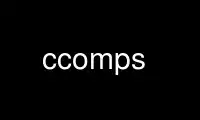
This is the command ccomps that can be run in the OnWorks free hosting provider using one of our multiple free online workstations such as Ubuntu Online, Fedora Online, Windows online emulator or MAC OS online emulator
PROGRAM:
NAME
ccomps - connected components filter for graphs
SYNOPSIS
ccomps [ -sxvenzC? ] [ -X[#%]s[-f] ] [ -ooutfile ] [ files ]
DESCRIPTION
ccomps decomposes graphs into their connected components, printing the components to
standard output.
OPTIONS
The following options are supported:
-e Do not induce edges in the connected components.
-s No output graph is printed. The return value can be used to check if the graph is
connected or not.
-x Only the connected components are printed, as separate graphs.
-v Counts of nodes, edges and connected components are printed.
-z Sort components by size, with the largest first. This is only effective if either
-x or -X# is present. Thus, -zX#0 will cause the largest component to be printed.
-C Use clusters in computing components in addition to normal edge connectivity. In
essence, this gives the connected components of the derived graph in which nodes
top-level clusters and nodes in the original graph. This maintains all subgraph
structure within a component, even if a subgraph does not contain any nodes.
-n Do not project subgraph structure. Normally, if ccomps produces components as
graphs distinct from the input graph, it will define subgraphs which are
projections of subgraphs of the input graph onto the component. (If the projection
is empty, no subgraph is produced.) If this flag is set, the component contains
only the relevant nodes and edges.
-X node_name
Prints only the component containing the node node_name, if any.
-X# start
-X# start-
-X# start-last
Prints only components in the given range of indices. In the first form, only the
component whose index is start, if any, is printed. In the second form, each
component whose index is at least start is printed. In the last form, only those
components whose indices are in the range [Istart,last] are printed. Thus, the
flag -x is equivalent to -X#0-.
-X# min
-X# min-
-X# min-max
Prints only components in the given range of sizes. In the first form, only a
component whose size is min, if any, is printed. In the second form, each
component whose size is at least min is printed. In the last form, only those
components whose sizes are in the range [Imin,max] are printed.
-o outfile
If specified, each graph will be written to a different file with the names derived
from outfile. In particular, if both -o and -x flags are used, then each connected
component is written to a different file. If outfile does not have a suffix, the
first file will have the name outfile; then next outfile_1, then next outfile_2,
and so on. If outfile has a suffix, i.e., has the form base.sfx, then the files
will be named base.sfx, base_1.sfx, base_2.sfx, etc.
By default, each input graph is printed, with each connected component given as a subgraph
whose name is a concatenation of the name of the input graph, the string "_cc_" and the
number of the component.
OPERANDS
The following operand is supported:
files Names of files containing 1 or more graphs in dot format. If no files operand is
specified, the standard input will be used.
RETURN CODES
Unless used to extract a single connected component, ccomps returns 0 if all the input
graphs are connected; and non-zero if any graph has multiple components, or any error
occurred. If just extracting a single component, ccomps returns 0 on success and non-zero
if an error occurred.
Use ccomps online using onworks.net services
